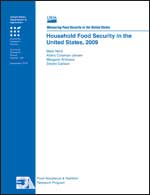Household Food Security in the United States, 2009
by
Mark Nord,
Alisha Coleman-Jensen,
Margaret Andrews, and Steven Carlson
Economic Research Report No. (ERR-108) 68 pp, November 2010
 Eighty-five percent of American households were food secure throughout the entire year in 2009, meaning that they had access at all times to enough food for an active, healthy life for all household members. The remaining households (14.7 percent) were food insecure at least some time during the year, including 5.7 percent with very low food security. In households with very low food security, the food intake of one or more household members was reduced and their eating patterns were disrupted at times during the year because the household lacked money and other resources for food. Prevalence rates of food insecurity and very low food security were essentially unchanged from 14.6 percent and 5.7 percent, respectively, in 2008, and remained at the highest recorded levels since 1995, when the first national food security survey was conducted. The typical food-secure household spent 33 percent more on food than the typical food-insecure household of the same size and household composition. Fifty-seven percent of all food-insecure households participated in one or more of the three largest Federal food and nutrition assistance programs during the month prior to the 2009 survey.
Eighty-five percent of American households were food secure throughout the entire year in 2009, meaning that they had access at all times to enough food for an active, healthy life for all household members. The remaining households (14.7 percent) were food insecure at least some time during the year, including 5.7 percent with very low food security. In households with very low food security, the food intake of one or more household members was reduced and their eating patterns were disrupted at times during the year because the household lacked money and other resources for food. Prevalence rates of food insecurity and very low food security were essentially unchanged from 14.6 percent and 5.7 percent, respectively, in 2008, and remained at the highest recorded levels since 1995, when the first national food security survey was conducted. The typical food-secure household spent 33 percent more on food than the typical food-insecure household of the same size and household composition. Fifty-seven percent of all food-insecure households participated in one or more of the three largest Federal food and nutrition assistance programs during the month prior to the 2009 survey.
Keywords: Food security, food insecurity, low food security, very low food security, hunger, food expenditures, food spending, food pantries, Food Stamp Program, Supplemental Nutrition Assistance Program, SNAP, National School Lunch Program, WIC
In this publication...
Need help with PDFs?